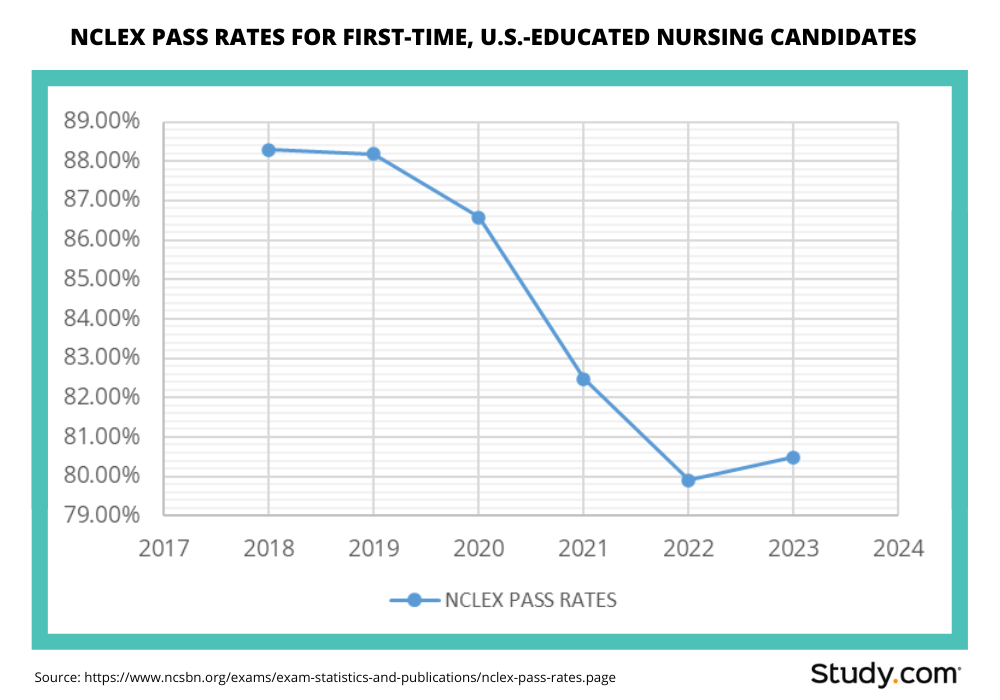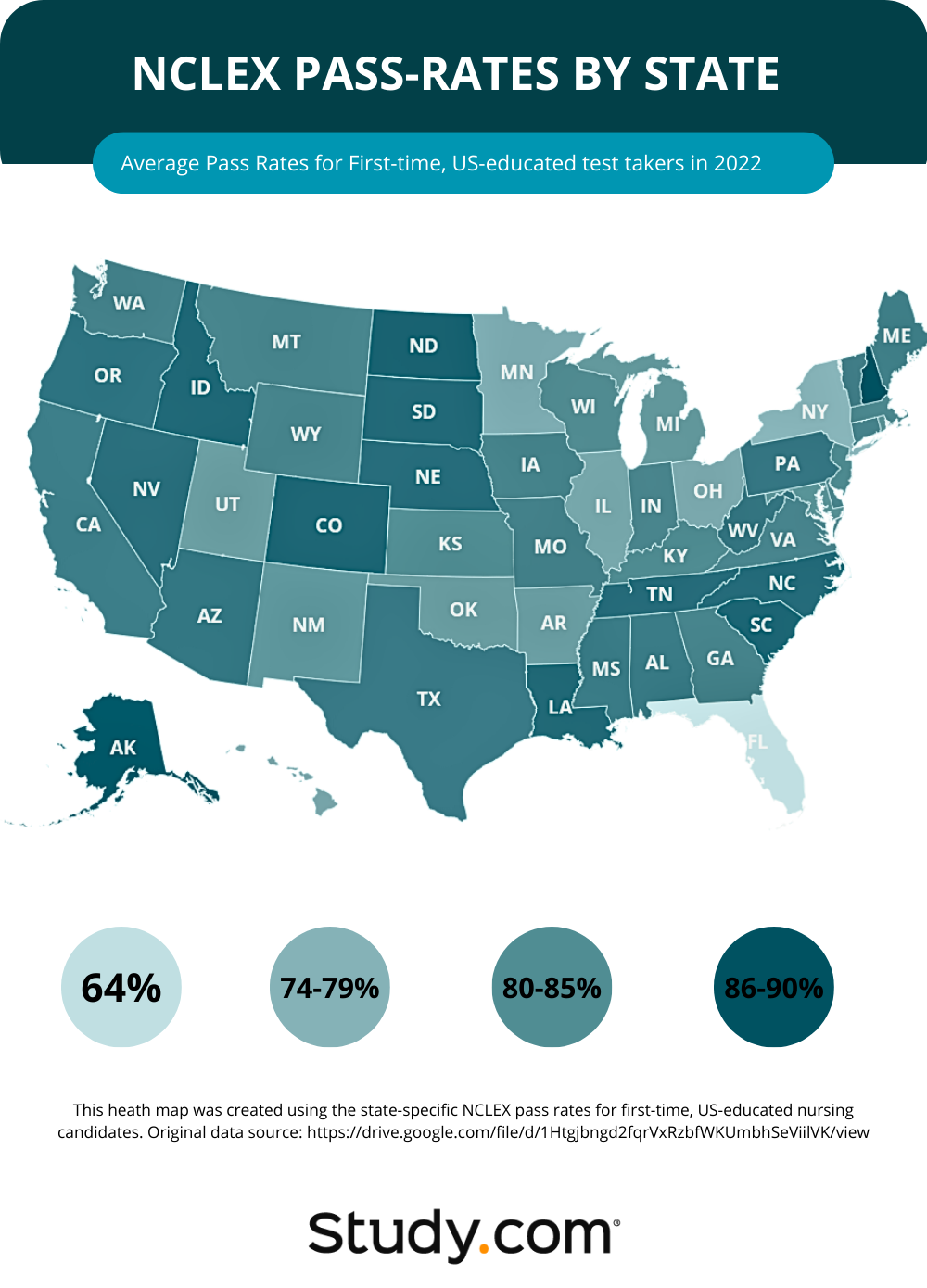
Comparing nursing school pass rates across the US—and what they say about the state of nursing education
Comparing nursing school pass rates across the US—and what they say about the state of nursing education
In the United States, becoming a registered nurse is a significant milestone marked by passing the National Council Licensure Examination (NCLEX).
The NCLEX is a comprehensive and standardized exam that covers critical areas of nursing, including a safe care environment, health maintenance, and reduction of risk potential. The goal is to ensure that nursing professionals are ready for the responsibilities that come with the job.
Typically, the journey towards tackling the NCLEX starts near the end of a nursing student's educational program. It's the culmination of years of learning and practice, a significant step towards fulfilling a commitment to the healthcare profession.
Unfortunately, recent data shows that NCLEX pass rates have been on the decline and that there are significant discrepancies in first-time pass rates across the states. This is alarming since the US is amid a nursing shortage. Any factor reducing the number of available nurses is troubling.
Study.com compiled data from the National Council of State Boards of Nursing (NCSBN) - a non-profit organization that includes nursing regulatory bodies from all U.S. states and territories - to gain a comprehensive understanding of the situation.

Why NCLEX pass rates have declined
NCLEX pass rates are impacted by many factors such as changes in testing and student preparedness. One of the most significant factors that has led to a sharp decline in pass rates is the COVID-19 pandemic. The pandemic led to a transition toward online learning, which made it difficult for students to learn practical nursing skills through clinical hours. After COVID-19 restrictions were implemented, there has been a steady decline in the NCLEX pass rates.
To put this into perspective, let's turn to some hard numbers. Before the pandemic, in 2019, first-time US-educated nursing candidates boasted a pass rate of 88%. With the onset of COVID-19 and subsequent restrictions in 2020, a small dip was observed, bringing the pass rate to 87%. The trend continued as online classes became the norm, with the pass rates sliding further to 83% in 2021 and 80% in 2022.
However, as the world slowly returned to a semblance of normalcy in 2023, distance learning restrictions eased and there seemed to be a glimmer of improvement: The pass rate for the NCLEX has shown a modest uptick, currently standing at 80.5%.

What do licensing pass rates say about the state of nursing education?
The NCLEX pass rates are the benchmark metric used to evaluate nursing school efficiency. However, the NCSBN admits that relying solely on NCLECX pass rates when measuring program efficiency could lead to a phenomenon known as "teaching to the examination." This overemphasis on exam preparation may limit broader learning and skill development. It underscores the need for a comprehensive approach to assessing program quality.
Additionally, there are concerns that the NCLEX's multiple-choice format can create an unfair disadvantage for underrepresented minority students that possess unique learning strengths, preferences, and perspectives that deviate from the Eurocentric viewpoint.
Moreover, when nursing programs overly focus on sustaining high NCLEX pass rates, they might unintentionally stack the deck against students who shine in hands-on clinical situations but struggle with written tests. The troubling result is that some promising students, deemed unlikely to ace the NCLEX on their first go, could be prematurely weeded out.
Because of the limitations of using NCLEX pass rates as a sole metric of success, NCSBN has suggested investigating other signs that indicate an underperforming nursing program, such as high turnover rates of program directors and other faculty members, complaints to nursing regulatory bodies from students, staff members or the public. Recognizing these issues early can help enhance the quality of nursing education.

State trends show a range of pass rates
According to most recent state-specific data on first-time pass rates, the NCLEX pass rates ranged from 64% to over 90% across the United States in 2022, with a national average pegged at around 80%.
The data shows that there is no regional area that dominates with pass rates; in fact, states show a wide range of percentage differences compared to their nearest geographic neighbors.
Population size also doesn't necessarily signal success: While the two largest states, California and Texas, both show average to above-average rates, the third largest state is Florida, which lands at the bottom of the country at 64%. New York, fourth in the country for population size, also hits the second-lowest rate at 74%.
Tiny New Hampshire, the tenth least populous state, set the pace with the highest NCLEX pass rate of 90%, a testament to the state's commitment to excellence in nursing education.
Trending just below average, states including Minnesota, Hawaii, Ohio, Arkansas, and Utah underscore that the challenges in nursing education don't recognize geographical borders.
New Mexico, Maryland, and Rhode Island sit comfortably at the national average.
This story was produced by Study.com and reviewed and distributed by Stacker Media.



